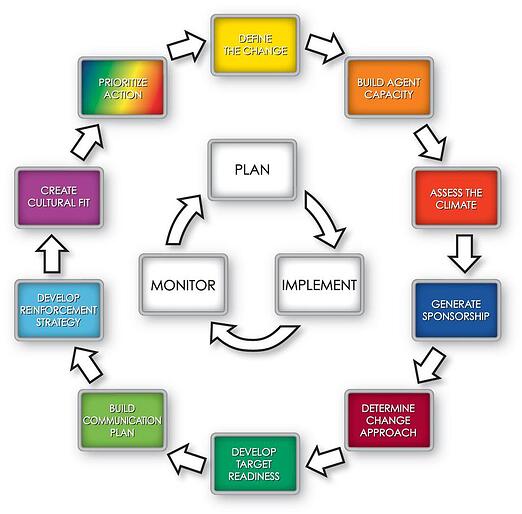Imagine you are driving 65 miles an hour along the highway and your “check engine” light comes on. What do you do? If that happened to us, we would pull over immediately and assess the situation. Would we have the same reaction if the “low windshield wiper fluid” light illuminated...definitely not. 
Implementing transformational change in your organization can easily be compared to having to react to the dashboard lights while driving a car. Similar to the guidance your car’s warning system provides, your change management methodology should guide your way. And like highway driving, business transformation is definitely not linear, so your change management process should not be either {Tweet This}.
The AIM Road Map
The Accelerating Implementation Methodology (AIM) is derived from core principles that provide directional guidance during a project’s lifecycle. These principles provide the basis for a flexible, iterative approach to change that reflects the reality of implementation.
Remember, the goal of change management, or what we prefer to call “implementation management,” shouldn’t be "to do" AIM, but rather to have these core principles guide us on what we should be doing now, given the project realities and challenges. The principles of the AIM change management methodology are depicted in a cyclical road map. They are:

|
AIM Element |
Core Principle |
|
Defining the Change |
Stakeholders need to have a commonly held definition of both the present state and the desired future state. |
|
Build Change Agent Capacity |
Implementation success requires the right number of change agents, with the right skills, traits, and characteristics, located in the right places. |
|
Assess the Climate |
No change occurs in isolation; it occurs in a context of all those priorities competing for resources, and is impacted by organizational stress and past implementation history and cultural patterns. |
|
Generate Sponsorship |
Committed Sponsorship is the single most important factor in ensuring swift and successful implementation. The priority is always to develop the cascade of Sponsors that individually and collectively demonstrate commitment by what they express, model and reinforce. |
|
Determine the Change Approach |
Change Agents must be ambidextrous. Use a “hammer” for compliance changes, and use transition management for commitment-based changes where you need to win over “hearts and minds.” |
|
Develop Target Readiness |
Resistance to change is inevitable. It must be managed. It cannot be denied, discounted, deferred to, or defeated. |
|
Build Communication Plan |
You must communicate in the Frame of Reference of each Target, with a built-in feedback loop for every communication so you can check for understanding and identify sources of resistance. |
|
Develop Reinforcement Strategy |
There is no change unless there is behavior change, and there is no behavior change without a change in reinforcement. You are either reinforcing the change, or reinforcing the status-quo. |
|
Create Cultural Fit |
If your project conflicts with the current culture, culture wins unless you are significantly altering the reinforcements. |
|
Prioritize Action |
You must blend the technical side and the human side of project management. |
4 Tips to Steering Your Transformation in the Right Direction
So how does this play out in the real world of project implementation? Where should you concentrate your energies? It’s simple... just let the principles guide your way. 
Tip #1- Use measurement tools to focus your energies in the right places at the right times. Use the Implementation History Assessment (IHA) to gain a systemic look at where you are likely to face common barriers like weak Sponsorship, a risk-averse culture, or missing reinforcements. Combine the IHA with the Implementation Risk Forecast (IRF), which measures the risks and barriers on your specific project. Analyzed together, you’ll have a good idea of where you need to concentrate your time, energy and resources.
Tip #2- Make building the cascade of Sponsorship your first priority. When you have Sponsors at each level of the organization that express, model and reinforce their commitment to the business change, you get acceleration. Since active Sponsorship represents a factor of 50% or more of the likelihood of implementation success, you should always make certain that you are asking for what you need from your Sponsors by using a well-planned Sponsor-contracting process as the framework for your conversations.
Tip#3- Develop an implementation plan that incorporates the core AIM deliverables. Investing time and energy up-front to plan to develop a proper and robust implementation plan (blended with the technical project plan) that’s continuously monitored will pay significant dividends. Focus your plan based on the results of your IHA and IRF, with a strategic emphasis on Defining the Change, Generating Sponsorship, Developing Readiness, Building a Communication Plan, and Developing a Reinforcement Strategy.
Tip#4- Build readiness early to reduce the costs of managing resistance later. Remember whether your transformational change is perceived as positive or negative, you will have resistance. If you spend some of your resource energy early in the project life cycle on building readiness (and this requires more than top-down communications through email, a web-site, or similar common communication-plan elements that have no feedback loop) you’ll spend less time and need fewer resources dealing with resistance later.
If you are serving in an internal change management consulting role to a business transformation effort, there is great value in having a set of core principles guide your way. But remember, these core principles are more than just words; they should be used to “steer” you toward a successful change. It’s change management’s GPS...by the dashboard lights.


